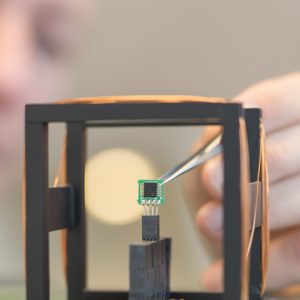CHALLENGE
Our customer is a leading global organization providing components and technology solutions to electronics manufacturing companies around the world. We were handed the responsibility of a current sensor IC that monitors charge/discharge current of a rechargeable battery, e.g. in a mobile phone, while remaining insensitive to the variations of the supply voltage. We took charge of the entire design trajectory along with evaluation that was needed to make the final product better than competition.
SOLUTION
The aim was to measure high-side current irrespective of the supply voltage that ranged from 1.8 V to 4.5 V. Sense current range was 1 mA to 1000 mA, using an external sense resistor of 10 mΩ. The basic principle for this current sensor is based on the conversion of the current through a (small) external resistor into a voltage. We developed an advanced differential voltage measurement circuit which is insensitive to the common-mode (=supply) level. The differential voltage to be measured is very small (microVolt to milliVolt range). Exact design specifications were defined during the design phase in collaboration with the customer, which allowed functionalities to be implemented optimally for the final product. Despite uncertainties in specifications and IC process models fully functional first silicon was quickly realized, and then the entire product development was covered in very short time.
TIME
First-silicon design and layout in 3 months from start to tape-out.
WE ARE PROUD
A versatile and robust differential voltage sensor architecture was developed, including analog amplification, analog-to-digital conversion (ΣΔ) and a digital bus-interface. To beat the challenge to measure differential voltages in the range of microVolts while the offset voltage of an uncompensated amplifier in this technology was 10 mV, we successfully developed a highly-efficient offset compensation mechanism.
The clever design incooperated an easy way to interact between multiple voltage domains; a high-side voltage domain containing the amplifier and ADC and a low-side domain containing the interface.
The IC was developed in a customer-specific low-cost CMOS process technology (0.6 µm). We started with setting up a custom PDK with very limited process information. Our experience of working with CMOS technologies on various nodes and ‘SystematIC’ design methodologies helped us to create robust circuits and achieve the satisfactory performance parameters. Besides good measurement accuracy also a very low power consumption was achieved, in operation (uA range) as well as in standby (nA range).

BENEFITS FOR CUSTOMER
- Customer received a versatile and robust (high-side) differential voltage readout circuit
- Suitable for various generations of sensor products including current sense over a sense resistor
- Low-power circuit designs
- Circuit design and layout in customer-owned process
- Supported IC evaluation and final IC product definition
- The quick realization of a functional first-silicon prototype opened up test opportunities and refinement of the final product definition and specifications which implied a significant gain in time-to-market.
KEY TECHNICAL STATISTICS
- Process: 0.6 µm CMOS
- High-resolution differential voltage sensing (10 uV)
- Common-mode (Supply) input range 1.8 V to 4.5 V
- Current consumption: 3 µA (at 10 measurements per second)
- Non-linearity: <1 %
- Standby current: in nA range
OUR OTHER SUCCESS STORIES
IC solutions that are tailor made for you can help you achieve your business goals.
SystematIC was founded to help businesses envision, plan, and develop such custom IC solutions.










